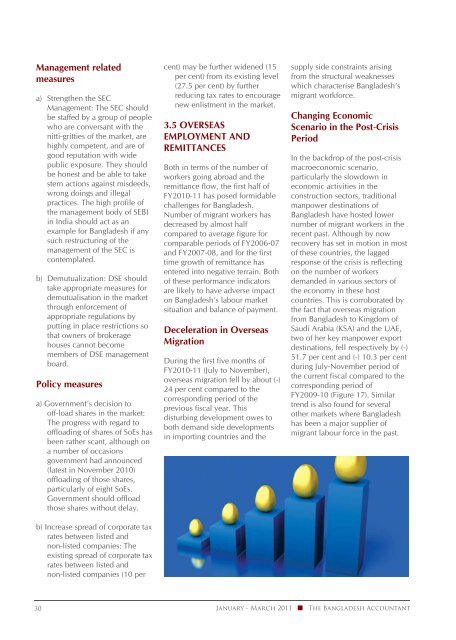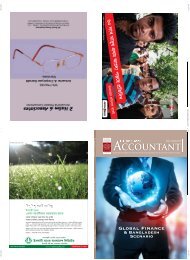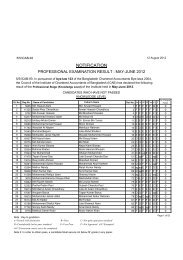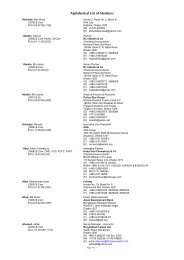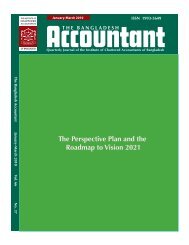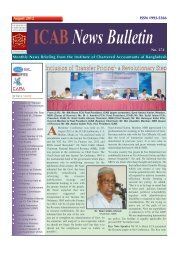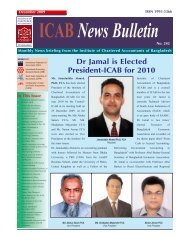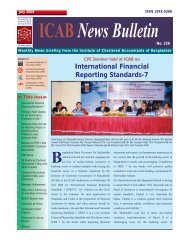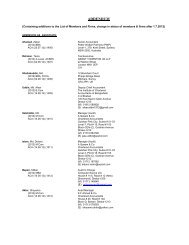Forma # 1.ai - ICAB
Forma # 1.ai - ICAB
Forma # 1.ai - ICAB
Create successful ePaper yourself
Turn your PDF publications into a flip-book with our unique Google optimized e-Paper software.
Management related<br />
measures<br />
a) Strengthen the SEC<br />
Management: The SEC should<br />
be staffed by a group of people<br />
who are conversant with the<br />
nitti‐gritties of the market, are<br />
highly competent, and are of<br />
good reputation with wide<br />
public exposure. They should<br />
be honest and be able to take<br />
stern actions against misdeeds,<br />
wrong doings and illegal<br />
practices. The high profile of<br />
the management body of SEBI<br />
in India should act as an<br />
example for Bangladesh if any<br />
such restructuring of the<br />
management of the SEC is<br />
contemplated.<br />
b) Demutualization: DSE should<br />
take appropriate measures for<br />
demutualisation in the market<br />
through enforcement of<br />
appropriate regulations by<br />
putting in place restrictions so<br />
that owners of brokerage<br />
houses cannot become<br />
members of DSE management<br />
board.<br />
Policy measures<br />
a) Government’s decision to<br />
off‐load shares in the market:<br />
The progress with regard to<br />
offloading of shares of SoEs has<br />
been rather scant, although on<br />
a number of occasions<br />
government had announced<br />
(latest in November 2010)<br />
offloading of those shares,<br />
particularly of eight SoEs.<br />
Government should offload<br />
those shares without delay.<br />
b) Increase spread of corporate tax<br />
rates between listed and<br />
non‐listed companies: The<br />
existing spread of corporate tax<br />
rates between listed and<br />
non‐listed companies (10 per<br />
cent) may be further widened (15<br />
per cent) from its existing level<br />
(27.5 per cent) by further<br />
reducing tax rates to encourage<br />
new enlistment in the market.<br />
3.5 OVERSEAS<br />
EMPLOYMENT AND<br />
REMITTANCES<br />
Both in terms of the number of<br />
workers going abroad and the<br />
remittance flow, the first half of<br />
FY2010‐11 has posed formidable<br />
challenges for Bangladesh.<br />
Number of migrant workers has<br />
decreased by almost half<br />
compared to average figure for<br />
comparable periods of FY2006‐07<br />
and FY2007‐08, and for the first<br />
time growth of remittance has<br />
entered into negative terrain. Both<br />
of these performance indicators<br />
are likely to have adverse impact<br />
on Bangladesh’s labour market<br />
situation and balance of payment.<br />
Deceleration in Overseas<br />
Migration<br />
During the first five months of<br />
FY2010‐11 (July to November),<br />
overseas migration fell by about (‐)<br />
24 per cent compared to the<br />
corresponding period of the<br />
previous fiscal year. This<br />
disturbing development owes to<br />
both demand side developments<br />
in importing countries and the<br />
supply side constraints arising<br />
from the structural weaknesses<br />
which characterise Bangladesh’s<br />
migrant workforce.<br />
Changing Economic<br />
Scenario in the Post‐Crisis<br />
Period<br />
In the backdrop of the post‐crisis<br />
macroeconomic scenario,<br />
particularly the slowdown in<br />
economic activities in the<br />
construction sectors, traditional<br />
manpower destinations of<br />
Bangladesh have hosted lower<br />
number of migrant workers in the<br />
recent past. Although by now<br />
recovery has set in motion in most<br />
of these countries, the lagged<br />
response of the crisis is reflecting<br />
on the number of workers<br />
demanded in various sectors of<br />
the economy in these host<br />
countries. This is corroborated by<br />
the fact that overseas migration<br />
from Bangladesh to Kingdom of<br />
Saudi Arabia (KSA) and the UAE,<br />
two of her key manpower export<br />
destinations, fell respectively by (‐)<br />
51.7 per cent and (‐) 10.3 per cent<br />
during July‐November period of<br />
the current fiscal compared to the<br />
corresponding period of<br />
FY2009‐10 (Figure 17). Similar<br />
trend is also found for several<br />
other markets where Bangladesh<br />
has been a major supplier of<br />
migrant labour force in the past.<br />
30<br />
January - March 2011<br />
The Bangladesh Accountant


